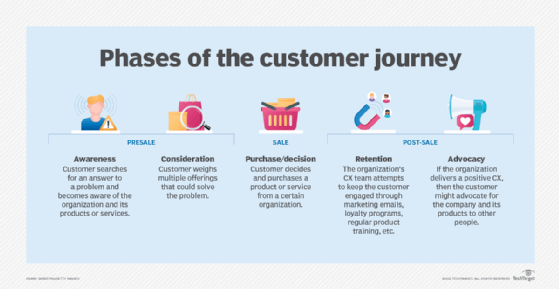
Getty Images/iStockphoto
Customer retention vs. acquisition: What's the difference?
Finding new customers can be a challenge, but so is keeping them happy and loyal to the business. This makes customer acquisition and retention critical to successful marketing.
In a competitive marketplace, businesses can stand out from the crowd if they prioritize customer satisfaction and brand loyalty.
However, customer satisfaction and loyalty both start with customer retention and customer acquisition. Although these strategies are complementary to one another, each one serves a different purpose within the customer journey.
Explore the differences between customer retention and customer acquisition, and how both create a balanced approach to increase revenue and expand business growth.
What is customer retention?
Customer retention measures a company's ability to keep existing customers over a period of time. Businesses with higher customer retention rates typically have customers who are satisfied with their service and continue to do business with them rather than with competitors.
Customer retention strategies help build long-term loyalty and can ultimately lead to increased revenue. These strategies can include the following:
- Personalization. Organizations that tailor their services and products to individual customers are more likely to see an increase in engagement, often through one-of-a-kind experiences to meet customers' needs and preferences.
- Gather feedback. Create surveys and collect reviews to gather insights on a customer's level of satisfaction. From each stage of the sales pipeline to marketing channels and customer support, businesses must understand what does and doesn't work for customers.
- Frequent communication. Regular communication with personalized messages or company updates can help customers feel more connected to a brand, whether through social media, email newsletters or special product offers.
- Loyalty programs. Businesses can encourage existing customers to continue buying from them with incentives, like a points system, discounts or limited-time offers on exclusive products.
- Prioritize customer service. Above all, friendly and efficient customer service is the best way to retain customers. Businesses should offer various channels for customer support, such as email, phone, chat or social media, to enable customers to connect with the team on any channel.
What is customer acquisition?
Customer acquisition is the process of bringing in new customers. As part of the initial stages of the customer journey, it often involves identifying potential customers, attracting them to a product or service, and leading them through the sales funnel until they become paying customers.
Customer acquisition strategies directly affect revenue growth, market expansion and brand awareness. Acquisition strategies can include the following:
- Content marketing and search engine optimization (SEO). Create relevant and value-based content to increase engagement with target audiences. Organizations can optimize their websites and online content with SEO keywords to rank higher in search engines and boost organic traffic.
- Paid advertising. If budgets allow, paid advertising on major search engines like Google can increase an organization's reach to a larger audience.
- Email marketing. An open line of communication through email can help marketers send personalized campaigns and nurture people through the sales funnel, while also giving customers easy access to the business.
- Industry events and webinars. A business that participates in events, trade shows and webinars can generate interest and leads while simultaneously showcasing itself and its expertise.
- Referral programs. Word-of-mouth advertising can help businesses gain new customers through their existing ones. This can include offering incentives -- like discounts and exclusive access to products or services -- to current customers to refer new people to the business.

5 differences between customer retention and acquisition
While both customer retention and customer acquisition can drive business growth, they serve different purposes and require specific approaches unique to each strategy.
1. Objectives and strategies
Customer acquisition uses data from marketing and sales teams to attract new clients with the goal of converting them into paying customers. Once they become customers, the customer retention strategy focuses on keeping them engaged and satisfied to stay loyal over time.
2. Cost
In most cases, customer acquisition costs more than retention, as companies must invest in marketing strategies to reach potential and target customers. Typical costs include marketing campaigns, advertising, promotional deals or product and service discounts. With customer retention, costs are usually lower, through strategies like loyalty programs and personalized marketing.
3. Marketing approach
Customer retention relies on personalized marketing efforts, often through email newsletters and customer satisfaction surveys. Customer acquisition incorporates broader marketing strategies to reach a wider audience, usually through content marketing, SEO and social media campaigns.
4. Timeframes
Customer acquisition operates on a much shorter timeline at the beginning of the customer journey. The goal is to quickly convert a new lead into a paying customer while their interest in a product or service is still piqued. Customer retention, on the other hand, focuses on long-term relationship building that encourages people to remain loyal and satisfied over time.
5. Types of relationships
Customer acquisition identifies target customers and sparks their interest in the business. Customer retention forms a deeper relationship with and understanding of the customer. Organizations can focus on customer preferences, incorporating feedback and enhancing the overall CX to ensure brand loyalty.
When to focus on customer retention vs. acquisition
While customer retention and acquisition strategies fit into different areas along the customer journey, they also suit businesses in different phases, such as well-established brands or companies releasing new products.
CX teams should focus on customer retention if the business has the following:
- High churn rate.
- Tight budget.
- Large customer base.
- Goal to improve customer lifetime value.
- Goal to build brand loyalty.
Alternatively, teams should focus on customer acquisition if the business has the following:
- Plan to release a new product or service.
- Small customer base or wants to grow their base.
- More one-time purchases than recurring business.
- Low market share.
- Objective to increase revenue.
Overall, customer retention and customer acquisition strategies are necessary components of any successful business. Both help create a balanced and comprehensive approach to business growth and focus on the unique goals along each step of the customer journey.
Editor's note: This article was updated to improve the reader experience.
Zaida Marston is a freelance content writer with more than 10 years of creative writing experience.






